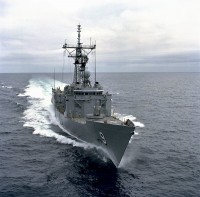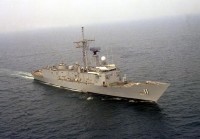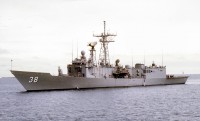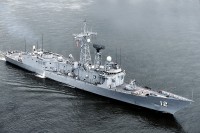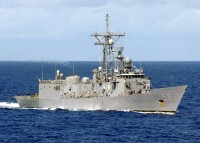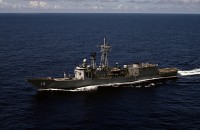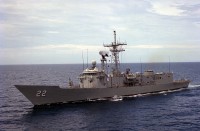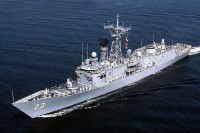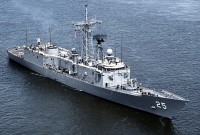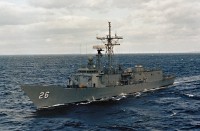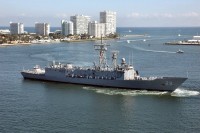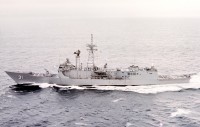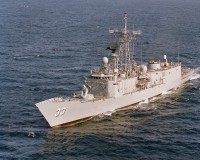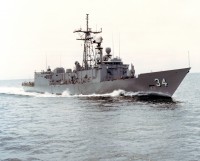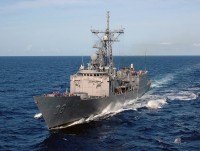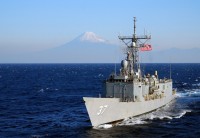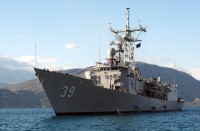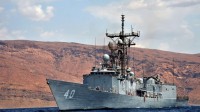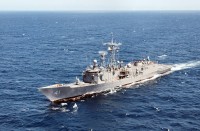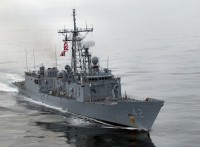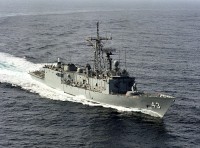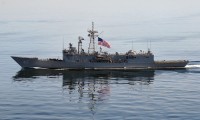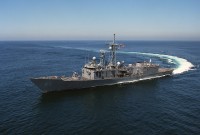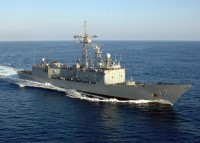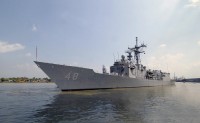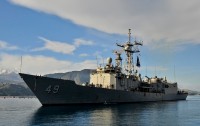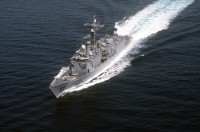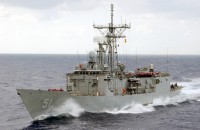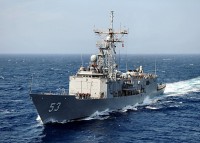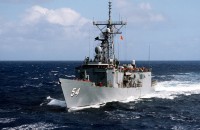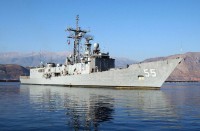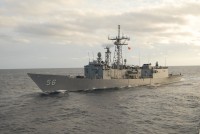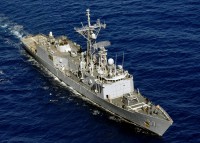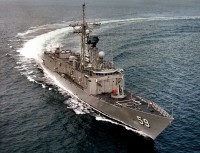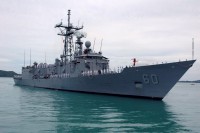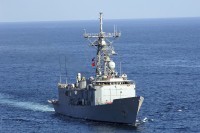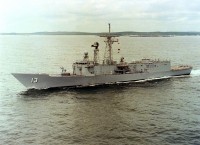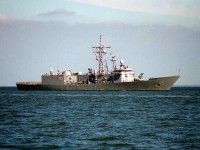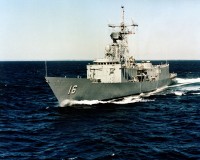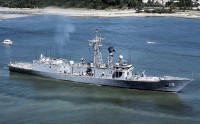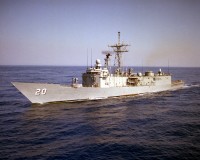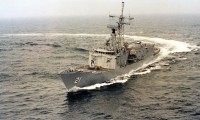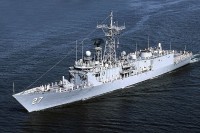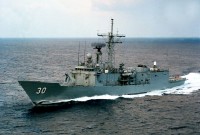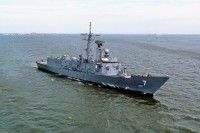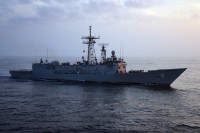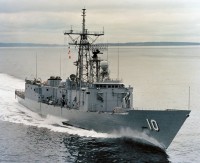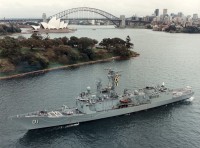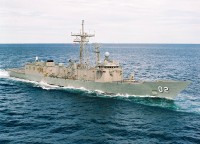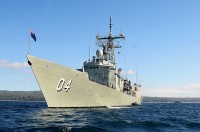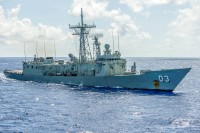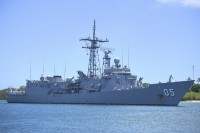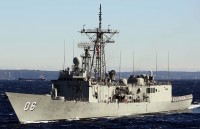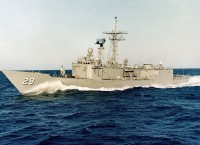Oliver Hazard Perry-class frigate
Basic information
Ship measurements
Machine
- 2 * General Electric LM2500-30 gas turbines generating 41,000 shp (31 MW) through a single shaft and variable pitch propeller
- 2 * Auxiliary Propulsion Units, 350 hp (260 kW) retractable electric azimuth thrusters for maneuvering and docking
Personnel
Combat assets
- AN/SPS-49 radar
- AN/SPS-55 radar
- Mk 92 fire control system
- SQS-56 sonar
- SQR-19 Towed Array sonar
- SLQ-32(V)2
- Flight III with sidekick
- Mark 36 SRBOC
- AN/SLQ-25 Nixie
- 1 * single-arm Mk 13 Missile Launcher with a 40-missile magazine that contains SM-1MR anti-aircraft guided missiles and Harpoon anti-ship missiles. Removed from the U.S. Navy ships starting in 2003, due to the retirement of the SM-1 missile from U.S. service
- 1 * Mk 38 Mod 2 Naval Gun Systems installed on platforms over the removed MK 13 launchers
- 2 * triple Mark 32 Anti-submarine warfare torpedo tubes with Mark 46 or Mark 50 anti-submarine warfare torpedoes
- 1 * OTO Melara 76 mm/62 caliber naval gun
- 1 * 20 mm Phalanx CIWS rapid-fire cannon
- 8 * Hsiung Feng II SSM or 4 HF-2 and 4 HF-3 supersonic AShM
- 2 * Bofors 40mm/L70 guns (on Taiwanese vessels only)
- 2 * LAMPS multi-purpose helicopters (the SH-2 Seasprite LAMPS I on the short-hulled ships or the SH-60 Seahawk LAMPS III on the long-hulled ships)
- double hangar
- flight deck
The Oliver Hazard Perry class is a class of guided-missile frigates named after the U.S. Commodore Oliver Hazard Perry, the hero of the naval Battle of Lake Erie. Also known as the Perry or FFG-7 (commonly «fig seven») class, the warships were designed in the United States in the mid-1970s as general-purpose escort vessels inexpensive enough to be bought in large numbers to replace World War II-era destroyers and complement 1960s-era Knox-class frigates.
In Admiral Elmo Zumwalt's «high low fleet plan», the FFG-7s were the low capability ships with the Spruance-class destroyers serving as the high capability ships. Intended to protect amphibious landing forces, supply and replenishment groups, and merchant convoys from aircraft and submarines, they were also later part of battleship-centred surface action groups and aircraft carrier battle groups/strike groups. Fifty-five ships were built in the United States: 51 for the United States Navy and four for the Royal Australian Navy (RAN). In addition, eight were built in Taiwan, six in Spain, and two in Australia for their navies. Former U.S. Navy warships of this class have been sold or donated to the navies of Bahrain, Egypt, Poland, Pakistan, Taiwan, and Turkey.
The first of the 51 U.S. Navy built Oliver Hazard Perry frigates entered into service in 1977, and the last remaining in active service, USS Simpson, was decommissioned on 29 September 2015. The retired vessels were either mothballed or transferred to other navies for continued service. Some of the U.S. Navy's frigates, such as USS Duncan (14.6 years in service) had fairly short careers, while a few lasted as long as 30+ years in active U.S. service, with some lasting even longer after being sold or donated to other navies. In 2020, the Navy announced the new Constellation-class as their latest class of frigates.
The ships were designed by the Bath Iron Works shipyard in Maine in partnership with the New York-based naval architects Gibbs & Cox. The design process was notable as the initial design was accomplished with the help of computers in 18 hours by Raye Montague, a civilian U.S. Navy naval engineer, making it the first ship designed by computer.
The Oliver Hazard Perry-class ships were produced in 445-foot (136 m) long «short-hull» (Flight I) and 453-foot (138 m) long «long-hull» (Flight III) variants. The long-hull ships (FFG 8, 28, 29, 32, 33, and 36–61) carry the larger SH-60 Seahawk LAMPS III helicopters, while the short-hulled warships carry the smaller and less-capable SH-2 Seasprite LAMPS I. Aside from the lengths of their hulls, the principal difference between the versions is the location of the aft capstan: on long-hull ships, it sits a step below the level of the flight deck in order to provide clearance for the tail rotor of the longer Seahawk helicopters.
The long-hull ships carry the RAST (Recovery Assist Securing and Traversing) system (also known as a Beartrap (hauldown device)) for the Seahawk, a hook, cable, and winch system that can reel in a Seahawk from a hovering flight, expanding the ship's pitch-and-roll range in which flight operations are permitted. The FFG 8, 29, 32, and 33 were built as «short-hull» warships but were later modified into «long-hull» warships.
Oliver Hazard Perry-class frigates were the second class of surface ship (after the Spruance-class destroyers) in the US Navy to be built with gas turbine propulsion. The gas turbine propulsion plant was more automated than other Navy propulsion plants at the time and could be centrally monitored and controlled from a remote engineering control center away from the engines. The gas turbine propulsion plants also allowed the ship's speed to be controlled directly from the bridge via a throttle control, a first for the US Navy.
American shipyards constructed Oliver Hazard Perry-class ships for the U.S. Navy and the Royal Australian Navy (RAN). Early American-built Australian ships were originally built as the «short-hull» version, but they were modified during the 1980s to the «long-hull» design. Shipyards in Australia, Spain, and Taiwan have produced several warships of the «long-hull» design for their navies.
The Oliver Hazard Perry-class frigates were designed primarily as anti-aircraft and anti-submarine warfare guided-missile warships intended to provide open-ocean escort of amphibious warfare ships and merchant ship convoys in moderate threat environments in a potential war with the Soviet Union and the Warsaw Pact countries. They could also provide air defense against 1970s- and 1980s-era aircraft and anti-ship missiles. These warships are equipped to escort and protect aircraft carrier battle groups, amphibious landing groups, underway replenishment groups, and merchant ship convoys. They can conduct independent operations to perform such tasks as surveillance of illegal drug smugglers, maritime interception operations, and exercises with other nations.
The addition of the Naval Tactical Data System, LAMPS helicopters, and the Tactical Towed Array System (TACTAS) gave these warships a combat capability far beyond the original expectations. They are well suited to operations in littoral regions, and for most war-at-sea scenarios.
Ships57
- Comments
 en
en ru
ru uk
uk
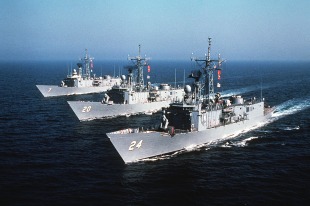



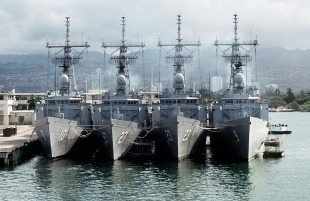
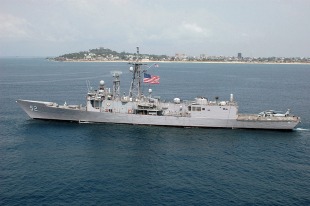
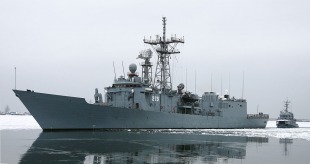
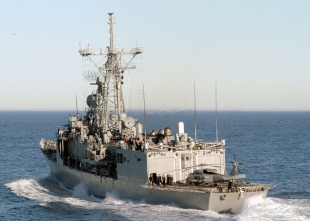

 Polish Navy
Polish Navy Pakistan Navy
Pakistan Navy Egyptian Navy
Egyptian Navy Turkish Naval Forces
Turkish Naval Forces Chilean Navy (Armada de Chile)
Chilean Navy (Armada de Chile) Republic of China Navy (Taiwan)
Republic of China Navy (Taiwan) Royal Bahrain Naval Force
Royal Bahrain Naval Force Royal Australian Navy
Royal Australian Navy Spanish Navy
Spanish Navy United States Navy
United States Navy Bath Iron Works (BIW)
Bath Iron Works (BIW)